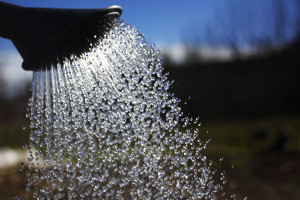Beneficial microorganisms are a vital part of the soil and, consequently, an important part of plants food. They are also an essential part of organic composts. But there is an enemy of these micro-organisms: chlorine.
These micro-organisms are very important for the soil food web. They are micro, but they have a big function in the soil, because they directly affect the plants food, breaking down organic matter and converting it into a form that is readily available to plants. We not only find beneficial micro-organisms in forests or gardens, but also in substrates, soils and composts we use for potted soil and growing at home.
Bacteria and Fungi in plants
Bacteria and fungi are two kinds of beneficial soil micro-organisms we find living near plants to feed from their green matter. At the same time, they help plants to achieve the food they need, into a form readily available for them.
 Bacteria are the oldest, most primitive forms of life and come in three styles or shapes: spiral, coccus and rod-shaped. In nature, bacteria serve as one of the main decomposers of organic matter, second only to fungi, making them a vital part of the soil food web. As they decompose organic matter, the bacteria ingest organic carbon compounds, nitrogen and any other elemental nutrients present. When the bacteria dies, all these nutrients are held in the soil. The process by which the nutrients are converted into plant-accessible forms is called mineralization.
Bacteria are the oldest, most primitive forms of life and come in three styles or shapes: spiral, coccus and rod-shaped. In nature, bacteria serve as one of the main decomposers of organic matter, second only to fungi, making them a vital part of the soil food web. As they decompose organic matter, the bacteria ingest organic carbon compounds, nitrogen and any other elemental nutrients present. When the bacteria dies, all these nutrients are held in the soil. The process by which the nutrients are converted into plant-accessible forms is called mineralization.
Another example of beneficial micro-organisms are mycorrhizae, a type of fungi that growers include in composts to protect plants roots from diseases that can affect them, and to guarantee a better absorption of nutrients. In nature, these kind of fungi and plants have a mutually beneficial relationship, because they help each other to get food.
Beneficial micro-organisms are also used for avoiding parasites and other pests. By using specialized micro-organisms, like Bacilus Thuringiensis to kill worms, we can protect our plants from different parasites that affect their growth and health.
Organic compost and beneficial micro-organisms
Growers know about the importance of nutrients for the plants. A good soil is one of the basis for the plants growth and for this reason they use quality composts and fertilizers to stimulate the soil.
Beneficial micro-organisms are an important part of organic fertilizers. They improve the soil, and allow the beneficial micro-organisms to easily convert the organic matter into food available to plants.
Chlorine, the enemy
However, even with the positive effects that these micro-organisms have, there is an enemy for them: Chlorine, and especially in summer. All municipal water supplies contain chlorine, a chemical disinfectant used to kill off deadly bacteria and virus in the water supply. With hot weather, there are more possibilities of bacteria and virus, so the levels of chlorine in the water are even higher.
As chlorine is used to eliminate bacteria from water that can affect the human body, irrigating with chlorinated water can also kill the beneficial micro-organisms that live in the soil near plants, and that we find in every potting soil.
To obtain a chlorine-free water, High Capacity Activated Carbon Block Filters are used, which are incorporated into all our water treatment systems, designed exclusively for hydroponics and gardening.
Eliminating chlorine from your water is the best way to maintain the effects of beneficial micro-organisms in our plants.









